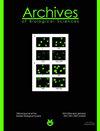SET and MYND domain-containing protein 2 (SMYD2): A prognostic biomarker associated with immune infiltrates in cervical squamous cell carcinoma and endocervical adenocarcinoma
IF 0.8
4区 生物学
Q4 BIOLOGY
引用次数: 1
Abstract
The histone lysine methyltransferase SET (Suppressor of variegation, Enhancer of Zeste, Trithorax) and MYND (Myeloid-Nervy-DEAF1) domaincontaining protein (SMYD2) plays a role in the tumorigenesis of cervical squamous cell carcinoma and endocervical adenocarcinoma (CESC). However, the prognostic significance of SMYD2 in CESC and the link between SMYD2 and tumor-infiltrating immune cells are unknown. The prognostic value of SMYD2 in CESC was obtained from The Cancer Genome Atlas (TCGA). SMYD2 mRNA and protein were both highly expressed in CESC compared with normal tissues. The high expression of SMYD2 was associated with advanced tumor status and poor prognosis in CESC patients. SMYD2 was an independent prognostic factor for overall survival. In vitro experiments with knockdown of SMYD2 suppressed CESC cell migration and invasion. The online tumor immune estimation resource (TIMER) and Kaplan-Meier analysis results revealed that the infiltration of CD4+ T and CD8+ T cells was related to poor prognosis. In TIMER-based multivariate Cox regression analysis, CD8+ T cells and SMYD2 were demonstrated as independent prognostic factors of CESC. In conclusion, our data suggest that high SMYD2 expression is a predictor of poor prognosis in CESC patients; SMYD2 could serve as a prognostic biomarker and molecular therapeutic target for CESC.SET和MYND结构域蛋白2 (SMYD2):与宫颈鳞状细胞癌和宫颈腺癌免疫浸润相关的预后生物标志物
组蛋白lysine methyltransferase SET (Suppressor of varation, Enhancer of Zeste, Trithorax)和MYND (Myeloid-Nervy-DEAF1) domaincontaining protein, SMYD2)在宫颈鳞癌和宫颈腺癌(endocervical adencarcinoma, CESC)的发生过程中发挥重要作用。然而,SMYD2在CESC中的预后意义以及SMYD2与肿瘤浸润性免疫细胞之间的联系尚不清楚。SMYD2在CESC中的预后价值来自癌症基因组图谱(TCGA)。与正常组织相比,CESC中SMYD2 mRNA和蛋白均高表达。SMYD2的高表达与CESC患者的晚期肿瘤状态和不良预后相关。SMYD2是总体生存的独立预后因素。体外实验表明,敲除SMYD2可抑制CESC细胞的迁移和侵袭。在线肿瘤免疫估计资源(TIMER)和Kaplan-Meier分析结果显示CD4+ T和CD8+ T细胞浸润与预后不良有关。在基于timer的多变量Cox回归分析中,CD8+ T细胞和SMYD2被证明是CESC的独立预后因素。总之,我们的数据表明SMYD2高表达是CESC患者预后不良的预测因子;SMYD2可作为CESC的预后生物标志物和分子治疗靶点。
本文章由计算机程序翻译,如有差异,请以英文原文为准。
求助全文
约1分钟内获得全文
求助全文
来源期刊
CiteScore
1.40
自引率
0.00%
发文量
25
审稿时长
3-8 weeks
期刊介绍:
The Archives of Biological Sciences is a multidisciplinary journal that covers original research in a wide range of subjects in life science, including biology, ecology, human biology and biomedical research.
The Archives of Biological Sciences features articles in genetics, botany and zoology (including higher and lower terrestrial and aquatic plants and animals, prokaryote biology, algology, mycology, entomology, etc.); biological systematics; evolution; biochemistry, molecular and cell biology, including all aspects of normal cell functioning, from embryonic to differentiated tissues and in different pathological states; physiology, including chronobiology, thermal biology, cryobiology; radiobiology; neurobiology; immunology, including human immunology; human biology, including the biological basis of specific human pathologies and disease management.

 求助内容:
求助内容: 应助结果提醒方式:
应助结果提醒方式:


